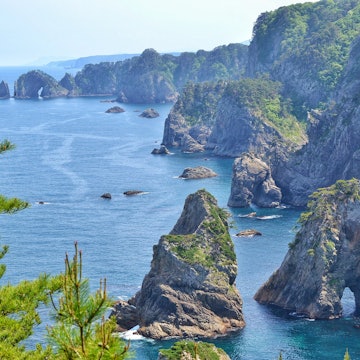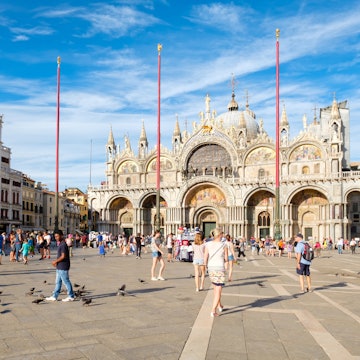
Trying the traditional crafts of Ishikawa prefecture
Sponsored by
Mar 15, 2021 • 5 min read

The historic samurai and geisha quarters of Kanazawa are the perfect backdrop for an arts and crafts scene – from silk to ceramics – that has been practiced for centuries © cowardlion / Shutterstock
For a small, remote coastal prefecture on Japan’s northern sea coast, Ishikawa features far more than its fair share of cultural attractions. From the romantically subdued cosmopolitan grandeur of Kanazawa, to the quiet, end-of-the-road crafts hamlet of Wajima near the tip of the Noto Peninsula, Ishikawa’s cultural offering is one of the most diverse in Japan.

A home for the arts
A great place to start your tour of Ishikawa’s crafts scene is the Ishikawa Prefectural Museum of Traditional Arts and Crafts. Happily, it’s situated in a serene corner of Kenrokuen, a star attraction of Kanazawa in its own right. The so-called ‘perfect garden,’ Kenrokuen allegedly took more than 200 years to design, opening only to the public in 1874. It’s beautiful in every season and all weather, but perhaps best in the very early morning, when the sunlight slants through the trees and the crowds are thin.
Take a stroll through the park and be ready when the museum opens at 9am. You’ll need a few hours to take it all in. Start with the museum’s collection of exquisite Mizuhiki jewellery and decorations, made from twisted paper cords. The cords are then woven into intricate shapes and designs. It’s said that during the city’s heyday, Kanazawa’s samurai made mizuhiki as a side project, using their creations to tie up their hair in topknots.

Colourful ceramics
From there, move to the Kaga region, home to some of Japan’s most lauded ceramics which are proudly displayed at the museum. Kutani ceramics are characterised by detailed scenes of nature, people, and landscapes in bold, dark colours, said to be inspired by the cold, grey winters of the Ishikawa coast. The first kiln to fire Kutani ceramics was set up in the 17th century, after the feudal lord of the Maeda clan ordered people in this region to learn to make porcelain of the quality he required. Some ceramic pieces from this era can still be seen in museums and private collections, although they are incredibly rare and valuable.
In the 19th century, Kutani ceramic artisans transitioned to wide variety of styles. One in particular, using more red pigments and gold overlay, became a sensation in Europe in the late 19th century and remains popular to this day. Modern Kutani artisans have branched out significantly, using Kutani overlay techniques to adorn sneakers and USB flash drives.

Bolts of colour
Finally, before you leave the museum to walk back through the garden, don’t miss the display of intricate silk dyed in the yuzen technique from the nearby town of Kanazawa, famous for its healing natural hot springs. The yuzen technique, originating in Kanazawa and developed over five centuries ago, uses five principal colors – red, yellow, indigo, green, and purple – and the dyes are all derived from natural sources.
The application of the dye to the silk is a process, typically involving a gradation dyeing technique called bokashi, resulting in a sense of depth and dimension. Kimono and other silks dyed using the yuzen technique are luxury garments, precious and extremely valuable. The technique is famous throughout the prefecture and all Japan. In fact, in the Kanazawa shinkansen (bullet train) station, you can even see examples of yuzen silk dyeing at the entrance to the public restrooms, encased in glass: a red motif for women, and blue for men.
Before leaving Kanazawa, don’t miss the opportunity to stroll through the city’s historic samurai and geisha quarters, with their charming and beautiful old wooden storefronts and hidden courtyards. It’s here where these crafts were practiced for centuries, and in some cases, still are today.

A golden touch
Your next stop is the Noto Peninsula, Japan’s wild and rugged finger, which is Honshu’s most prominent reach into the Sea of Japan. The largest city on the peninsula is Wajima, an old fishing and commercial port renowned for its fine lacquerware. The Hokuriku shinkansen has opened Kanazawa and the whole Ishikawa region up to the rest of Japan, and Wajima has become a destination for young urban types looking to snap up some old-style crafts and soak up the atmosphere.
Strolling the fabulous Asa-ichi morning market to watch hip young families from Kanazawa haggle with old salts selling lacquerware, and dried whole squid is a delightful way to spend an hour or two – especially when you’re fueled by the excellent coffee from Kalpa.
But you came here for the lacquerware, which artisans in this region have been producing since the 15th century. Time your visit to coincide with an exhibit at the Ishikawa Wajima Museum of Urushi Art, which features a rotating collection of traditional and modern Wajima lacquerware, as well as items from elsewhere in Asia, displayed over two floors.
Here, you can also learn about the painstaking craftsmanship that goes into the production of traditional Wajima lacquerware: starting from the collection of sap from the deciduous urushi tree, its preparation and application, and finally – for very special lacquerware pieces – the application of gold leaf or gold powder.

Bringing it all together
If you’d like to buy some lacquerware, head back to Kalpa – the barista is a fifth-generation lacquerware craftsman, and his family’s wares are for sale in the cafe.
Alternatively, if you’d like to experience Wajima lacquerware in the place it was produced, book an overnight stay at the Oyado Tanaka ryōkan (traditional Japanese inn) in Wajima. Dinner is an exquisite kaiseki (Japanese haute cuisine) feast of super-fresh local seafood served on delicate Wajima lacquerware. It’s a wonderful way to experience Japan’s traditional culture still in practice today.
This article was written in partnership with Ishikawa Travel
Sponsored by Ishikawa Travel
As a travel entertainment and inspirational media outlet, we sometimes incorporate brand sponsors into our efforts. This activity is clearly labeled across our platforms.
This story was crafted collaboratively between Ishikawa Travel and Lonely Planet. Both parties provided research and curated content to produce this story. We disclose when information isn’t ours.
With sponsored content, both Lonely Planet and our brand partners have specific responsibilities:
-
Brand partner
Determines the concept, provides briefing, research material, and may provide feedback.
-
Lonely Planet
We provide expertise, firsthand insights, and verify with third-party sources when needed.















